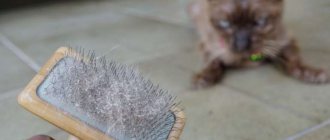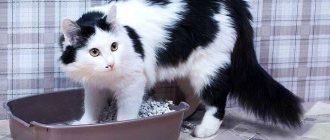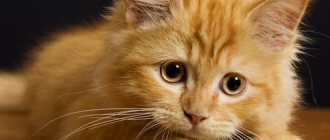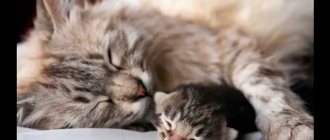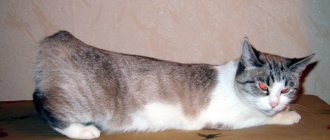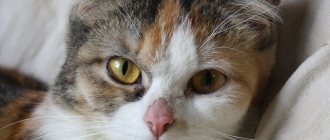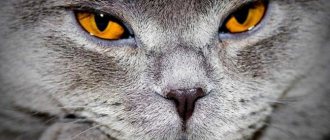A vertical tail is always welcome in cats. A cat that holds its tail high and proud feels healthy and confident. This means that when a cat's tail hangs, it causes anxiety. It is necessary to determine whether this sudden weakness of the tail is voluntary or the result of injury.
Sometimes cats intentionally drag their tails along the ground due to emotional distress. If your cat is physically unable to lift her tail, one of the tail bones may be broken. Additionally, the cat could have dislocated its tail from the base of its spine.
There is a difference between a cat that doesn't want to lift its tail and one that is physically unable to do so. The first, although a concern, can be a lifestyle issue and can be easily resolved. If your cat is physically unable to lift its tail, it will need to be examined by a veterinarian.
Why does a cat have a tail hanging down?
What makes a cat's tail hang? This may be a problem due to anxiety or unhappiness, or due to physical trauma. Either way, your cat needs help.
Like most animals, a nervous cat will hold its tail low. You can even squeeze it between your legs. Find out if anything is causing your cat discomfort or uncertainty. Common explanations for nervousness in cats include:
| Loneliness or mourning: | Cats are not as lonely and independent as they seem. Your cat may be pining for a lost companion or former owner. |
| Victim of bullying: | Households with multiple pets fall into a natural dominant and submissive dynamic. Make sure it doesn't cross the line into bullying. |
| External threats: | Cats have a keen sense of smell and hearing. Your cat may smell a dog outside or become nervous about loud noises in the distance. |
| Changes in the program: | Have you changed your shift patterns, moved home, or adjusted your meal times? Change makes cats anxious. |
| Impending unpleasant experience: | If your cat sees you pick up her carrier, she associates this with a trip to the vet. This will make the cat nervous and worried. |
A drooping tail can also be a sign that your cat is feeling defeated. Cats love to feel in control of their affairs, so if your cat feels like she has resigned herself to abuse and suffering, this is not quality of life at all.
However, do not be fooled into thinking that a drooping tail is always a sign of meekness. Just as a high, prominent tail can signify the happiness of aggression, the same can be said for a low position.
Hunting cats hold their tail low and often swing it from side to side before pouncing on their prey. Your cat may be preparing to attack, usually in self-defense.
Of course, all of this assumes that your cat is intentionally keeping her tail low to the ground. You must find out whether this action is voluntary. If your cat is physically unable to lift her tail, this automatically causes more concern.
© shutterstock
When should you sound the alarm?
Reasons why a cat lowers its tail:
- A strong blow or fracture can cause the cat to not raise its tail.
- Damage to nerve endings is also a possible problem. It is impossible to start treatment, since this organ is an extension of the spine and its integrity is necessary for full-fledged work.
- Stroke - if the animal is of advanced age, this will cause the cat to have a hanging tail . In this case, the veterinarian will prescribe antibiotics that will return the tail to its normal position in whole or in part. But relapse can happen again.
- Nerve problems - living in stressful conditions. For example, if a cat is oppressed, often beaten, or he is simply not yet accustomed to new owners who have just adopted a new four-legged friend, then he will behave nervously. At such moments, you should not rush to establish a connection with the cat, because good relationships are formed over time, when the animal gets used to the new environment.
- Safety of your offspring. It’s not uncommon for cats to want to protect kittens from exposure to humans or other dangers. This often happens if a pregnant cat does not have her own secluded place where she can safely give birth and raise her offspring. Until the time comes, she will walk from corner to corner with her tail lowered, and look for a suitable option.
- Hereditary predisposition. Often, after crossing different breeds, kittens with deformities are born. Most often, such a developmental deviation does not cause discomfort.
- If the animal is tired, then this position will be a characteristic feature. In this case, the cat needs to be allowed to sleep and rest.
Almost all symptoms will be accompanied by a lack of appetite and unusual behavior.
Why doesn't my cat's tail move?
As mentioned, whether to keep your cat's tail high and proud or low and harmless should be a conscious decision. The tail should at least twitch and change position. What does it mean when a cat's tail doesn't move? Often a completely immobile tail is a sign of injury.
This could be a tail or lower back injury, such as a dislocation or fracture. It may also be due to nerve damage. There are tests you can run to see if your cat is able to move its tail. This includes:
- Look for signs of physical damage to your cat's tail . Swelling at the base is a common symptom.
- Stroke the cat from head to tail . Cats with pain at the base of the tail will not respond well to being touched in this area. Expect to be scratched or hissed.
- Play with the cat . This should show the natural movement of the tail as part of the interaction.
Treatment of the disease
As a rule, the only effective treatment method is timely surgery. There is nothing strange about this: if the appearance of a “cauda equina” was provoked by injuries or pathologies leading to physical deformation of the structure of the spinal column, it is unlikely that good results will be achieved with the help of drug treatment. However, it is unreasonable to abandon it completely.
Thus, sedatives are prescribed in cases where a sick animal is experiencing severe pain. In mild cases, it is believed to help improve the pet's quality of life at no additional cost. However, anti-inflammatory corticosteroids are usually prescribed at the same time, since simply relieving pain does not help relieve the root cause of the pathology.
Please note that even in cases of regular treatment, the disease often recurs, after which the therapeutic course must be repeated. Methylprednisolone has proven itself well. It is administered lumbosacral-epidurally at a dose of 1 mg per kilogram of live weight. This drug (in combination with sedatives) is reported to achieve clinical cure in approximately 59% of cases.
We also note that for “horsetail”, physiotherapy often becomes an indispensable method of treatment. Even a regular massage (if performed correctly) can improve the quality of life of a sick cat. Acupuncture is also indicated (surprisingly, in such a situation it really helps).
Tail injuries in cats
Impact trauma can prevent cats from lifting their tail. This symptom usually occurs due to a dislocated tail or a broken bone. In some rare cases, the problem may be in the cat's spinal cord. Cat tails are delicate and can be injured in many ways. Common causes of tail injuries in cats include:
- Crashed into the door
- The owner has arrived
- Twitching, usually as a child
- Bitten or involved in a conflict with another animal
At the first sign of a tail injury, first aid should be provided. According to the Veterinary Clinic of North America: Small Animal Practice, tail injuries often lead to pelvic problems. The cat will be in pain and may not recover without help.
Emotional factor
Emotional factors should be highlighted separately:
- First of all, it is a state of aggression. With its tail tucked, the pet feels protected. The animal also whips itself on the sides with the tip of its tail for a larger radius of protection;
- in a state of fear, the pet tries to shrink as much as possible. A female individual can thus protect offspring from possible danger. Numerous beatings and fights also intimidate the cat, as a result it shrinks into a ball;
- During sleep, the animal curls up into a ball. This is considered the most comfortable and protected resting position.
The cat has back problems
You should always rule out the possibility of spinal injury. This will have a number of consequences beyond the inability to raise the tail. Falls from heights or traffic accidents are the most common explanations for spinal injuries in cats.
The cat's tail is connected directly to the vertebrae, as well as to a number of muscles, tendons and ligaments. If a cat has an injured spine, this may affect the tail. The lower the back injury, the more likely it is that the cat will not be able to lift its tail. Besides an inability to lift its tail, warning signs that your cat is living with a back injury include:
- Uncoordinated, ugly gait
- Urinary incontinence (cecum and/or urinary incontinence)
- Inability to take care of yourself
- Muscle spasms
- Refusal to move
- Reluctance to be touched, including uncharacteristic aggression when petting
- Refusal of food and water
- Excessive verbalization to express pain
Cats are good at hiding pain or discomfort. If you suspect your cat has a back injury, contact your veterinarian. If this gets worse, your cat may be permanently immobilized.
© shutterstock
Unless your cat has a back injury, the problem will be localized to the tail. This has a better prognosis than a spinal injury, but it should still be taken seriously. Your first step is to determine the type of injury.
Nerve rupture
If a cat's tail hangs after a collision with another animal, then there is a possibility of a nerve rupture. If this happens, the pet will not only not be able to control part of the body, but its tail will not respond to external stimuli.
© shutterstock
Doing anything on your own is useless. You can't do it without qualified help. The damaged tail will most likely need to be amputated to prevent complications.
The cat's tail is dislocated
Cat tails are delicate and easily dislocate, especially when pulled. The tail is connected to the spine. This part of the cat's anatomy is known as the coccyx (sacrum).
A cat's spinal cord ends at approximately the fifth vertebra. After this, the back and tail are connected with tendons. This is sometimes called a "ponytail". This means that pulling and dislocating a cat's tail can cause nerve damage.
This will be very painful for the cat and will likely result in loss of bladder and bowel control. The sooner your cat is treated, the greater the chance of a full recovery since nerve damage is minimized. Unfortunately, relieving a dislocated tail is not easy. Your cat may never regain full control.
Congenital tail defects
We are talking about a structural feature of the tail, which occurs quite often in newborn kittens. According to statistics, some cat breeds are especially susceptible to congenital tail defects (for example, Burmese or Scottish fold cats).
In itself, such a hall is not scary and does not in any way threaten the life or health of the pet. You just have to remember that if a cat has a broken tail, the path to exhibitions and competitions among its own kind will be closed. Such an individual is considered to be out of condition, that is, not suitable in terms of body structure parameters. So an animal with a congenital crease will delight the eye and heart exclusively at home. You will have to forget about the career of a “cat model”.
Another important factor is the ability of cats to pass on the peculiarity of their tail structure by inheritance. In other words, future kittens have every chance of repeating the fate of the “crooked-tailed” parent. Moreover, this anomaly may worsen, and the offspring may develop complications in the form of spinal disorders, coordination of movements and many other troubles. This is why an animal with a crooked tail is not suitable for breeding. The best way out of the situation would be castration or sterilization.
